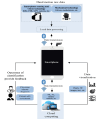Smartphone-Based Hand Function Assessment: Systematic Review
- PMID: 39283676
- PMCID: PMC11443181
- DOI: 10.2196/51564
Smartphone-Based Hand Function Assessment: Systematic Review
Abstract
Background: Hand function assessment heavily relies on specific task scenarios, making it challenging to ensure validity and reliability. In addition, the wide range of assessment tools, limited and expensive data recording, and analysis systems further aggravate the issue. However, smartphones provide a promising opportunity to address these challenges. Thus, the built-in, high-efficiency sensors in smartphones can be used as effective tools for hand function assessment.
Objective: This review aims to evaluate existing studies on hand function evaluation using smartphones.
Methods: An information specialist searched 8 databases on June 8, 2023. The search criteria included two major concepts: (1) smartphone or mobile phone or mHealth and (2) hand function or function assessment. Searches were limited to human studies in the English language and excluded conference proceedings and trial register records. Two reviewers independently screened all studies, with a third reviewer involved in resolving discrepancies. The included studies were rated according to the Mixed Methods Appraisal Tool. One reviewer extracted data on publication, demographics, hand function types, sensors used for hand function assessment, and statistical or machine learning (ML) methods. Accuracy was checked by another reviewer. The data were synthesized and tabulated based on each of the research questions.
Results: In total, 46 studies were included. Overall, 11 types of hand dysfunction-related problems were identified, such as Parkinson disease, wrist injury, stroke, and hand injury, and 6 types of hand dysfunctions were found, namely an abnormal range of motion, tremors, bradykinesia, the decline of fine motor skills, hypokinesia, and nonspecific dysfunction related to hand arthritis. Among all built-in smartphone sensors, the accelerometer was the most used, followed by the smartphone camera. Most studies used statistical methods for data processing, whereas ML algorithms were applied for disease detection, disease severity evaluation, disease prediction, and feature aggregation.
Conclusions: This systematic review highlights the potential of smartphone-based hand function assessment. The review suggests that a smartphone is a promising tool for hand function evaluation. ML is a conducive method to classify levels of hand dysfunction. Future research could (1) explore a gold standard for smartphone-based hand function assessment and (2) take advantage of smartphones' multiple built-in sensors to assess hand function comprehensively, focus on developing ML methods for processing collected smartphone data, and focus on real-time assessment during rehabilitation training. The limitations of the research are 2-fold. First, the nascent nature of smartphone-based hand function assessment led to limited relevant literature, affecting the evidence's completeness and comprehensiveness. This can hinder supporting viewpoints and drawing conclusions. Second, literature quality varies due to the exploratory nature of the topic, with potential inconsistencies and a lack of high-quality reference studies and meta-analyses.
Keywords: digital health; hand function assessment; mHealth; mobile health; mobile phone; rehabilitation; smartphone-based sensing.
©Yan Fu, Yuxin Zhang, Bing Ye, Jessica Babineau, Yan Zhao, Zhengke Gao, Alex Mihailidis. Originally published in the Journal of Medical Internet Research (https://www.jmir.org), 16.09.2024.
Conflict of interest statement
Conflicts of Interest: None declared.
Figures


Similar articles
-
Prescription of Controlled Substances: Benefits and Risks.2025 Jul 6. In: StatPearls [Internet]. Treasure Island (FL): StatPearls Publishing; 2025 Jan–. 2025 Jul 6. In: StatPearls [Internet]. Treasure Island (FL): StatPearls Publishing; 2025 Jan–. PMID: 30726003 Free Books & Documents.
-
A rapid and systematic review of the clinical effectiveness and cost-effectiveness of topotecan for ovarian cancer.Health Technol Assess. 2001;5(28):1-110. doi: 10.3310/hta5280. Health Technol Assess. 2001. PMID: 11701100
-
Health professionals' experience of teamwork education in acute hospital settings: a systematic review of qualitative literature.JBI Database System Rev Implement Rep. 2016 Apr;14(4):96-137. doi: 10.11124/JBISRIR-2016-1843. JBI Database System Rev Implement Rep. 2016. PMID: 27532314
-
Systemic pharmacological treatments for chronic plaque psoriasis: a network meta-analysis.Cochrane Database Syst Rev. 2021 Apr 19;4(4):CD011535. doi: 10.1002/14651858.CD011535.pub4. Cochrane Database Syst Rev. 2021. Update in: Cochrane Database Syst Rev. 2022 May 23;5:CD011535. doi: 10.1002/14651858.CD011535.pub5. PMID: 33871055 Free PMC article. Updated.
-
Comparison of self-administered survey questionnaire responses collected using mobile apps versus other methods.Cochrane Database Syst Rev. 2015 Jul 27;2015(7):MR000042. doi: 10.1002/14651858.MR000042.pub2. Cochrane Database Syst Rev. 2015. PMID: 26212714 Free PMC article.
References
-
- Fiems CL, Miller SA, Buchanan N, Knowles E, Larson E, Snow R, Moore ES. Does a sway-based mobile application predict future falls in people with Parkinson disease? Arch Phys Med Rehabil. 2020 Mar;101(3):472–8. doi: 10.1016/j.apmr.2019.09.013. doi: 10.1016/j.apmr.2019.09.013.S0003-9993(19)31311-5 - DOI - DOI - PubMed
-
- Yang K, Xiong WX, Liu FT, Sun YM, Luo S, Ding ZT, Wu JJ, Wang J. Objective and quantitative assessment of motor function in Parkinson's disease-from the perspective of practical applications. Ann Transl Med. 2016 Mar;4(5):90. doi: 10.21037/atm.2016.03.09. https://europepmc.org/abstract/MED/27047949 atm-04-05-90 - DOI - PMC - PubMed
Publication types
MeSH terms
LinkOut - more resources
Full Text Sources

